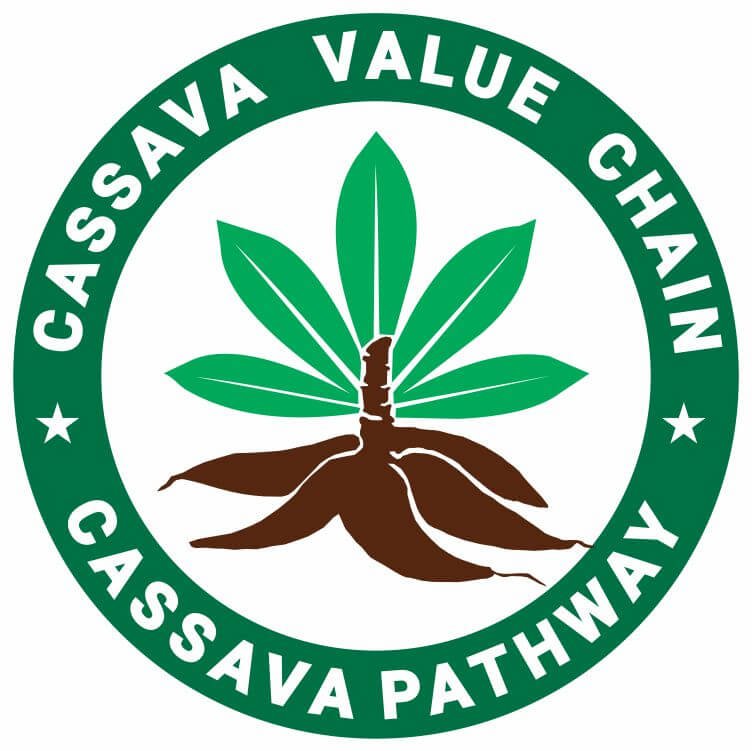Let’s discuss the environmental impact of cassava farming, from land degradation to water consumption. Find sustainable practices to mitigate these effects and ensure a healthier planet for future generations.
Cassava, an important food source for millions, also carries a weighty environmental footprint.
As demand for cassava grows, understanding its environmental consequences becomes essential.
Unregulated expansion of cassava cultivation can lead to deforestation, soil degradation, and loss of biodiversity, all posing threats to local environments and communities.
The heavy use of pesticides and fertilizers in commercial cassava production can lead to water pollution and adverse health effects for farmers and consumers alike.
Investigating the environmental impact of cassava farming practices is, therefore, needed to ensure sustainable agricultural development.
By understanding the challenges and benefits of cassava cultivation, stakeholders can work towards informed policies that promote food security while protecting the environment and public health.
Table of Contents
- Environmental Impact of Cassava Farming through Land Use and Deforestation
- Soil Health
- Water Usage
- Pesticide and Herbicide Use
- Greenhouse Gas Emissions
- Sustainable Practices
- Case Studies
- Conclusion
Environmental Impact of Cassava Farming through Land Use and Deforestation
Cassava farming has contributed to land use changes across various regions, which leads to deforestation.
This conversion of forested areas to agricultural land for cassava production raises serious environmental concerns.
According to recent studies, over 10 million hectares of forest land have been cleared in tropical regions, including parts of Africa and South America, to make way for cassava cultivation.
This statistic highlights the scale at which cassava farming impacts the environment.
The direct correlation between cassava farming and deforestation can be traced in areas such as Southeast Asia, where the rapid expansion of agricultural land has led to the destruction of vital forest habitats.
The loss of these forests diminishes biodiversity and disrupts ecosystems that rely on interdependencies between various species.
Recommended: Soil Requirements for Successful Cassava Farming
An example is the numerous animal species that depend on forest environments for shelter and food that are increasingly at risk as their habitats shrink due to the ongoing push for agricultural land.
Another example is the loss of forest cover which has broader ecological implications. Forests are active players in carbon sequestration, and their removal worsens greenhouse gas emissions, contributing to climate change.
The conversion of these ecosystems affects hydrological cycles, leading to soil erosion and altering water availability in the region.
Consequently, the fragile balance of local ecosystems is jeopardized, and wildlife is not only losing habitat but also facing serious competition for the diminishing resources available to them.
Related: Best Practices in Cassava Farming
Soil Health
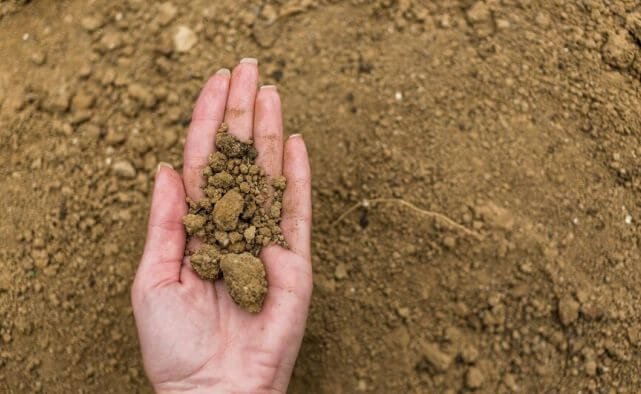
Cassava farming, particularly when practiced as monoculture, has implications for soil health.
Monoculture involves cultivating a single crop extensively over a large area, which is common in cassava farming due to its economic value and demand.
However, this practice can result in several detrimental effects on the soil, notably soil erosion and nutrient depletion.
Soil erosion occurs as a direct result of the lack of crop diversity. With only cassava planted, the system lacks the root structure provided by varied plants that can help hold the soil together.
This undermines the soil’s integrity, making it susceptible to erosion by wind and water.
Enhanced soil erosion can lead to a loss of topsoil, home to essential nutrients necessary for healthy plant growth, and decreases agricultural productivity over time.
Nutrient depletion is another critical concern in monoculture cassava farming. Continuous planting of cassava can lead to an imbalance of essential nutrients in the soil, as the same crop repeatedly extracts similar nutrients.
Unlike traditional agroecological practices, which promote biodiversity and nutrient recycling, monoculture does not allow for the replenishment of soil health.
Recommended: Top Producers of Cassava
Over time, this can result in a decline in soil fertility, ultimately affecting yields and broader agricultural sustainability.
The long-term consequences of failing to maintain healthy soil can extend beyond immediate agricultural impacts.
Poor soil health contributes to water quality degradation and negatively influences local ecosystems.
Therefore, promoting practices that improve soil health, such as crop rotation, cover cropping, and organic amendments, is important for cassava production and the environmental health of the surrounding area.
Implementing these practices can support sustainable agriculture, protect natural resources, and enhance productivity over the long term.
Related: Challenges in the Cassava Value Chain
Water Usage
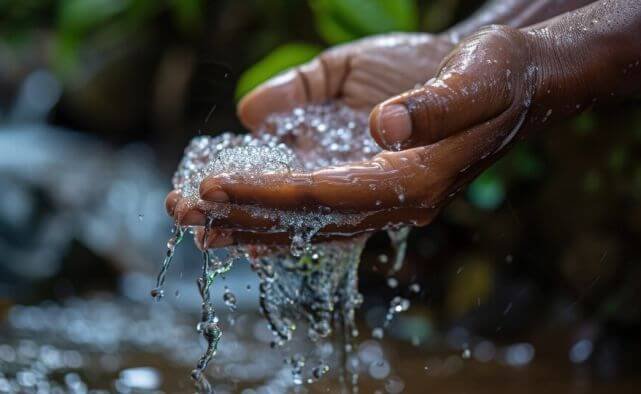
Cassava farming necessitates considerable water resources. The water requirements for cassava cultivation can vary significantly depending on the climate, soil type, and farming techniques employed.
Cassava is grown in moist to wet conditions, and while it is resilient to drought, optimal yields are achieved with proper water management.
It is essential to understand how this demand for water affects local water sources and ecosystems.
In many agricultural areas, the competition for freshwater resources is intensifying.
Cassava farming collides with other agricultural practices, such as rice and sugarcane cultivation, which also necessitate substantial water inputs.
This competition can strain local water supplies, particularly in regions where water scarcity is already a pressing issue.
Such competition may lead to over-extraction of groundwater or depletion of surface water bodies, impacting the availability of water for other uses, including drinking and sanitation for local communities.
Moreover, the ecological consequences of excessive water withdrawal cannot be overlooked.
Local ecosystems, including wetlands and rivers, are central to sustaining biodiversity and maintaining the health of the environment.
The disruption of these ecosystems due to the demands of cassava farming can lead to habitat loss and reduced water quality, negatively affecting both wildlife and human populations that rely on these resources for their livelihoods.
Thus, sustainable water usage practices in cassava farming are sacrosanct to preserving these necessary ecosystems and ensuring that water resources remain available for all users.
To mitigate these impacts, innovative water management strategies, such as rainwater harvesting and efficient irrigation systems, must be implemented.
Managing cassava farming’s water usage sustainably is essential to balancing agricultural productivity with environmental conservation, benefiting both farmers and local communities.
Related: Climate Impact on Cassava Farming
Pesticide and Herbicide Use
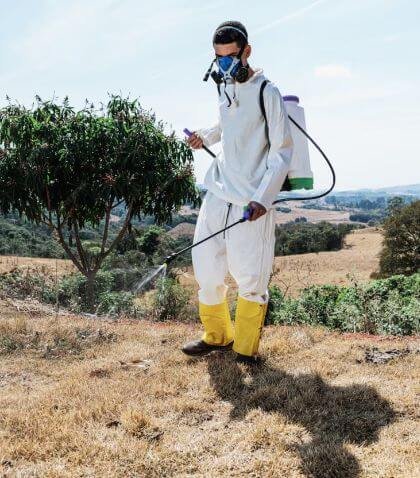
The cultivation of cassava especially in a commercial scale involves the application of pesticides and herbicides to protect yields from pests and weeds.
These chemicals, while important for agricultural productivity, pose risks to environmental health.
Commonly used pesticides include insecticides that target cassava pests like mealybugs and aphids, while herbicides are employed to control weed growth that competes with the cassava plants for nutrients and water.
However, the use of these chemicals can negatively impact soil health. Many pesticides and herbicides are designed to penetrate the soil, but as a consequence, they may disrupt the natural microbial communities essential for soil fertility.
These chemicals can diminish the organic matter and alter nutrient cycling, potentially leading to long-term degradation of soil health.
Moreover, their persistent residues can accumulate in agricultural systems, posing risks for future crops.
Another crucial concern regards water quality. Runoff from cassava fields treated with pesticides and herbicides can contaminate local waterways, threatening aquatic ecosystems and posing dangers to human health.
Chemicals entering water systems can lead to bioaccumulation in fish and other wildlife, impacting biodiversity and the overall health of the ecosystem.
Going further, the potential health impacts on farm workers cannot be overlooked.
Exposure to these hazardous chemicals during application and harvest can lead to acute and chronic health issues, including respiratory problems, skin irritations, and even more severe conditions like neurological disorders.
Consumers are also at risk since pesticide residues might remain on cassava products consumed by humans.
While pesticides and herbicides play a notable role in cassava farming, their adverse effects highlight the urgent need for integrated pest management practices that prioritize both crop productivity and environmental protection.
Greenhouse Gas Emissions
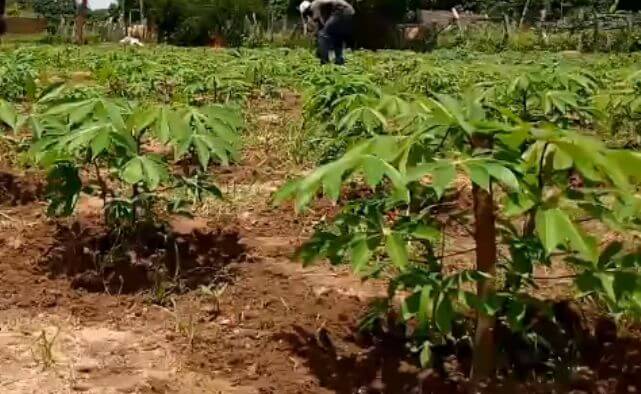
Understanding the carbon footprint associated with cassava cultivation is important in evaluating the environmental impacts of this crop.
Compared to other staple crops, cassava has a relatively lower carbon emission profile, primarily due to its ability to thrive on marginal land and its lower fertilizer requirements.
However, the emissions from cassava farming cannot be overlooked, as they arise from both direct and indirect sources.
Direct Emission
Direct emissions result from agricultural practices, such as fertilizer application and soil disturbances.
The use of nitrogen-based fertilizers can lead to nitrous oxide emissions, a potent greenhouse gas that contributes to climate change.
Also, soil tillage practices can release carbon stored in the soil, increasing the overall carbon footprint of cassava cultivation.
Proper management practices, including minimal tillage and the use of organic fertilizers, can help mitigate these emissions.
Indirect Emissions
Indirect emissions are closely linked to land-use change, particularly in regions where forests or grasslands are converted into cassava plantations.
This land conversion results in the loss of carbon sinks and also disrupts local ecosystems.
Thus, the expansion of cassava farming can inadvertently contribute to higher greenhouse gas emissions, as the carbon stored in forest biomass is released into the atmosphere.
The impact of land-use change often extends to biodiversity loss, which adds another layer of environmental concern.
While cassava may generally have a lower carbon emission than other crops, its cultivation practices and the pressures of land-use change need to be critically managed to minimize its environmental footprint.
Therefore, adopting sustainable farming techniques and preserving natural habitats are vital steps towards reducing the overall greenhouse gas emissions associated with cassava farming.
Sustainable Practices
Cassava farming has increasingly adopted sustainable practices to improve productivity while minimizing environmental impact.
These agroecological methods prioritize ecological balance and can be instrumental in promoting soil health, reducing pest pressures, and ensuring long-term sustainability in cassava production systems.
Let’s take a closer look at these sustainable practices:
Intercropping
Intercropping involves cultivating cassava alongside other crops. This approach maximizes land use and optimizes nutrient utilization.
By diversifying crop production, farmers can create a more resilient agricultural system that reduces the risk of pest outbreaks and disease.
An example is planting legumes with cassava, which can improve soil nitrogen levels and suppress weeds, leading to healthier cassava plants and improved yields.
Crop Rotation
Crop rotation is another essential sustainable practice. By alternating cassava with different crop species over several growing seasons, farmers can enhance soil fertility and disrupt the life cycles of pests and diseases that may target cassava.
Rotating cassava with crops such as maize or soybeans can help manage soil erosion and improve microbial biodiversity, which is critical for a thriving agricultural ecosystem.
Conservative Tillage and Cover Cropping Techniques
Moreover, adopting conservation tillage and cover cropping techniques further supports sustainable cassava farming.
Conservation tillage minimizes soil disturbance, preserving soil structure and moisture content, while cover crops can serve as protective ground cover, reducing erosion during the off-season.
This results in healthier soils that are better equipped to support cassava growth and resist adverse climatic impacts.
Certainly, the integration of sustainable practices in cassava farming not only promotes environmental stewardship but also contributes to food security and the livelihoods of farmers.
These methods offer a holistic approach to managing agricultural systems, aligning productivity with ecological responsibility.
Case Studies
The environmental implications of cassava farming have gained attention in recent years, prompting various initiatives aimed at promoting sustainable practices.
Several case studies illustrate how innovative strategies can mitigate the adverse effects associated with cassava cultivation.
Agroforestry Systems in Nigeria
One such initiative is the use of agroforestry systems in Nigeria. This method combines cassava planting with tree cultivation, effectively improving biodiversity while improving soil health.
Farmers involved in this program reported increased yields without resorting to chemical fertilizers, thus demonstrating a sustainable approach that benefits both the environment and local economies.
Use of Intercropping Techniques
Another notable example is found in Brazil, where farmers adopted intercropping techniques.
By cultivating cassava alongside legumes, these farmers improved nitrogen fixation in the soil, reducing the need for synthetic inputs.
Moreover, the crops’ complementary growth patterns promoted pest resistance, minimizing the reliance on pesticides.
This case serves as a compelling illustration of how integrating different crop species can lead to more resilient farming systems, ultimately benefiting the environment.
However, it is essential to mention negative instances as well. In some regions of Southeast Asia, extensive monoculture practices have led to soil degradation and loss of biodiversity.
The reliance on a single crop undermines ecosystem stability, creating vulnerabilities that can lead to severe economic repercussions for farmers.
These adverse outcomes highlight the critical need for diversification and sustainable agricultural practices within cassava farming.
Conclusion
Cassava farming significantly impacts the environment, particularly through deforestation, soil degradation, and biodiversity loss.
While it provides vital food security, unsustainable practices lead to ecological harm.
Sustainable methods like crop rotation, organic farming, and integrated pest management can reduce these effects.
Research into resistant cassava varieties and climate-smart practices is key to improving resilience while minimizing environmental damage.
Collaborative efforts from farmers, policymakers, and communities are essential to balance cassava’s agricultural importance with environmental protection.
Proactive solutions ensure sustainable cassava production without compromising ecosystems.
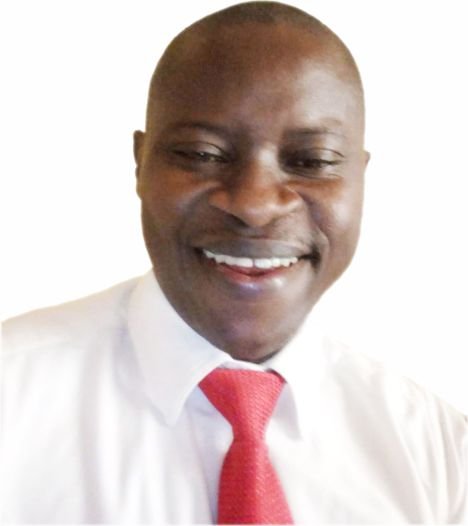
Chimeremeze Emeh is a writer and researcher passionate about Africa’s most transformative root crop—cassava. Through his work at cassavavaluechain.com, he explores the entire cassava industry, from cultivation and processing to its diverse applications in food, health, and industrial use.
He also writes for palmoilpalm.com, where he shares his extensive experience and deep-rooted knowledge of palm oil, covering red palm oil, palm kernel oil, and refined products. His work there reflects his lifelong connection to agriculture and his commitment to promoting sustainable value chains in Africa.
Driven by curiosity and purpose, Chimeremeze aims to shed light on how cassava continues to empower communities, strengthen food systems, and link traditional farming wisdom with modern innovation.
